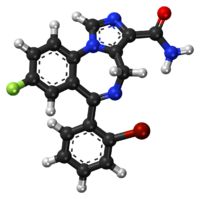Imidazenil
 | |
 | |
| Clinical data | |
|---|---|
| ATC code |
|
| Identifiers | |
| |
JSmol) | |
| |
| |
| (verify) | |
Imidazenil[1] is an experimental anxiolytic drug which is derived from the benzodiazepine family, and is most closely related to other imidazobenzodiazepines such as midazolam, flumazenil, and bretazenil.
Imidazenil is a highly potent
Imidazenil has not yet been developed commercially for use in humans, however it has been suggested as a safe and effective treatment for anxiety,[5] a potent yet non-sedating anticonvulsant which might be particularly useful in the treatment of poisoning with organophosphate nerve agents,[6][7] and as a novel treatment for schizophrenia.[8]
In rats, imidazenil has been demonstrated to have low tolerance or dependence liability, unlike other benzodiazepine receptor agonist ligands, such as diazepam, bretazenil.[9]
